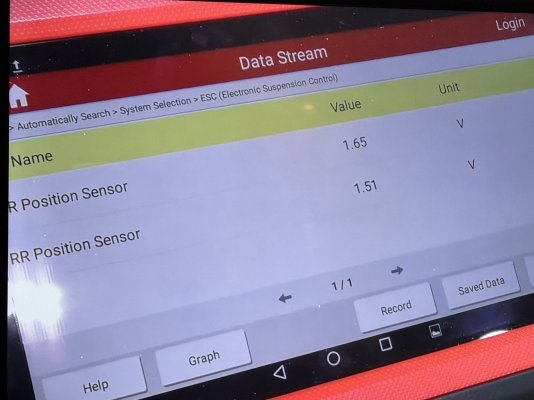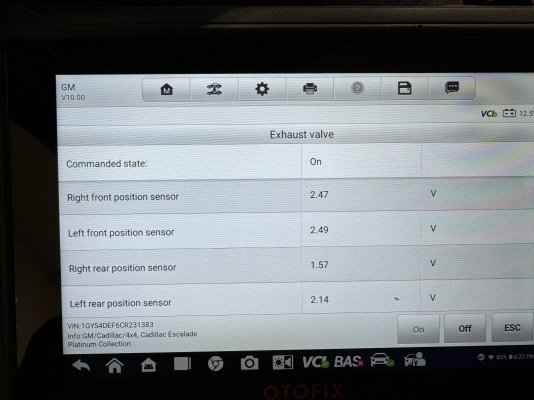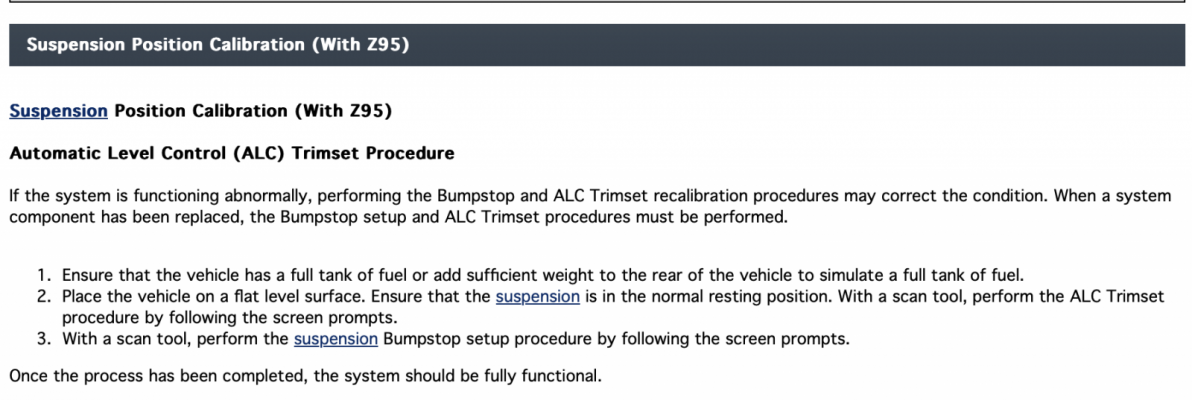Boydzz
TYF Newbie
- Joined
- May 26, 2021
- Posts
- 6
- Reaction score
- 4
Hello all - great forum here.
Vehicle in question is a 2012 Escalade Platinum AWD with Magneride Package (Z95). OEM Pump and shocks all around. No stored codes.
The issue is the compressor won't refill the bags to maintain the ~20psi of pressure in them. The compressor starts up fine every morning as the bags fully deflate overnight. At morning start-up, the compressor runs momentarily and fills to about ~15-20PSI. I am aware of a...smallish(?) leak on the right rear shock. Soapy water confirm the bag is leaking where it's clamped to the body. I'm planning to replace it with OEM prior to the summer's tow season. Left rear looks good and was replaced 4 years ago.
I have an Otofix scanner that runs Autel software. I can get get access to the suspension control module, perform tests and run the "bump stop" calibration. BTW the bump stop calibration has not fixed my problem.
Last summer I noticed the rear of the vehicle sagging while towing. A key cycle would cause the compressor to run and re-level, but as the system leaked down, the compressor wouldn't restart. This activity is occurring still. System works great at start up, but won't run again until restarted.
I'm leaning towards either a bad ride height sensor, or as others have mentioned here, a faulty vent solenoid valve, or something in the pump (It's old, crusty, and a bit noisy.
Ride Height sensor:
Does anyone know what the nominal value should be?
I've seen a YouTube video of a 2018(?) where as soon as the level "sagged" to from 1.99V to 2.0V the compressor would start up. Here's the url:
.
In another video of a NNBS I captured this screen shot, showing both sensors around 1.6V.
My sensors are in this image. Left Rear @ 2.14, Right Rear @ 1.57. This is flat in the garage.
I have manually disconnected and manipulated the right rear sensor and can get the compressor to turn on. I can't recall if I did that with the left rear.
Edit: Here's a video of the sensors in action as I manually activate the compressor. Note that vent solenoid auto opens after turning off the compressor.
We took a trip today and I took the scan to to monitor the ride height sensors and system pressure. Sensor function looked perfectly normal. For example going around a corner one sensor would extend and the other would contract. The dampening control for left and right rear shocks was mirroring as well. Meaning one side wasn't acting different than the other. Air pressure leaked down from about 20 psi to 3 psi in about 15 minutes drive time...slowish leak.
This is a lot of info, but still comes down to someone with a better understanding of the system...what triggers the system to re-activate as the air leaks out?
Vehicle in question is a 2012 Escalade Platinum AWD with Magneride Package (Z95). OEM Pump and shocks all around. No stored codes.
The issue is the compressor won't refill the bags to maintain the ~20psi of pressure in them. The compressor starts up fine every morning as the bags fully deflate overnight. At morning start-up, the compressor runs momentarily and fills to about ~15-20PSI. I am aware of a...smallish(?) leak on the right rear shock. Soapy water confirm the bag is leaking where it's clamped to the body. I'm planning to replace it with OEM prior to the summer's tow season. Left rear looks good and was replaced 4 years ago.
I have an Otofix scanner that runs Autel software. I can get get access to the suspension control module, perform tests and run the "bump stop" calibration. BTW the bump stop calibration has not fixed my problem.
Last summer I noticed the rear of the vehicle sagging while towing. A key cycle would cause the compressor to run and re-level, but as the system leaked down, the compressor wouldn't restart. This activity is occurring still. System works great at start up, but won't run again until restarted.
I'm leaning towards either a bad ride height sensor, or as others have mentioned here, a faulty vent solenoid valve, or something in the pump (It's old, crusty, and a bit noisy.
Ride Height sensor:
Does anyone know what the nominal value should be?
I've seen a YouTube video of a 2018(?) where as soon as the level "sagged" to from 1.99V to 2.0V the compressor would start up. Here's the url:
In another video of a NNBS I captured this screen shot, showing both sensors around 1.6V.

My sensors are in this image. Left Rear @ 2.14, Right Rear @ 1.57. This is flat in the garage.

I have manually disconnected and manipulated the right rear sensor and can get the compressor to turn on. I can't recall if I did that with the left rear.
Edit: Here's a video of the sensors in action as I manually activate the compressor. Note that vent solenoid auto opens after turning off the compressor.
We took a trip today and I took the scan to to monitor the ride height sensors and system pressure. Sensor function looked perfectly normal. For example going around a corner one sensor would extend and the other would contract. The dampening control for left and right rear shocks was mirroring as well. Meaning one side wasn't acting different than the other. Air pressure leaked down from about 20 psi to 3 psi in about 15 minutes drive time...slowish leak.
This is a lot of info, but still comes down to someone with a better understanding of the system...what triggers the system to re-activate as the air leaks out?
Last edited:

